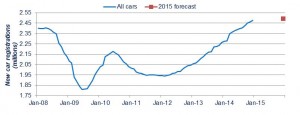 Does the fact that online retailer Amazon is phasing in a one-hour delivery service have any significance for automotive logistics? Yes, says Tim Fawkes, managing director of transport management experts, the 3T Group.
Does the fact that online retailer Amazon is phasing in a one-hour delivery service have any significance for automotive logistics? Yes, says Tim Fawkes, managing director of transport management experts, the 3T Group.
The news that Amazon has introduced a one hour delivery service for Prime customers may not have caused much of a stir in the automotive industry – but it should have.
The service is being phased in across parts of London and is expected to cover the whole of London and more UK cities by the end of 2015. Available on orders of £20 ($31) or more and costing £6.99, delivery within a two-hour window is at no additional cost between 8am and midnight. By offering customers this service, Amazon hope to sign up more Prime users (who currently pay an annual subscription of £79) and to increase its market share which will enable them to raise their game in competing with the high street.
On the surface, online retail and automotive manufacturing may appear to have little in common. However, Amazon’s new service has raised the bar even higher in transport services, with the company acknowledging that many consumers are increasingly seeking faster delivery. By giving customers what they want, Amazon may well have expedited the expectation of same day delivery across a whole range of industries, including automotive.
Meeting customer demand
So, how realistic is the one-hour (or even one-day) delivery within the automotive supply chain? There is certainly rising demand for many industries, including automotive, to provide an immediate service. Whilst a one hour delivery service may be untenable for substantial purchasing decisions such as buying a new car, there is increasing pressure on the automotive industry to provide a more dynamic service with a wider variety of options and quicker turnaround of orders. Customers no longer expect to wait six weeks for their new car, and so, the industry needs to react to customer demand – just as Amazon has done.
This has implications for the whole automotive supply chain, which in some organisations has potential for modernisation and the implementation of a more centralised logistics structure. Ultimately supply chain costs are an endemic part of a company’s businesses processes so require a long term sustainable system.
Dealing with multiple challenges
The automotive industry was one of those most significantly affected by the recession of 2008, so much so that it has only really recovered during the last 12 months. However, new car sales have now increased beyond the sales of 2008.

Whilst this is good news, it also poses a new problem for the industry. The outdated just-in-time (JIT) logistics systems put in place in the 1990s are simply not capable of delivering the flexibility and meeting the increasing demand that is potentially hitting the industry. This means that manufacturers and suppliers are facing the multiple challenges posed by a growing industry in which customers want their products within days (and potentially hours) of order, not weeks. In order to meet these challenges, organisations will need to introduce more dynamic manufacturing systems to cope with more changes more frequently – and possibly a modular approach to optional extras. This will mean more dynamic ordering from tier one suppliers and a more dynamic JIT transport plan to deliver supplier materials when the automotive manufacturer needs them.
The role of technology
Fortunately, with improved technology increasing visibility and control of the transport element, this can now be achieved. In fact, changing the transport plan dynamically to meet a changing manufacturing plan is something that is already in place in many industries. A dynamic multi carrier transport solution is better equipped to cope with different volume demands and changes in requirements. Integrated transport management systems (TMS) that are independent of carriers can also ensure that the manufacturer has better controls in place to manage the transport aspects of all carriers.
The newest and most revolutionary products on the market are smart phone tracking apps which can track the location of all consignments through these transport management systems, offering instant real time information for supplier, carrier and customer. These apps also have the significant advantage of being both affordable and available to any driver who has access to a smart phone. The resulting improved system based forecasting can then be used to provide suppliers and the transport management system with enough information to plan in advance of requirement. Furthermore, with web based visuals for suppliers, carriers and manufacturers available via web portals, there is no longer a need for complex systems installations and hardware on all parties’ systems. These web portals can be used to communicate demand, provide live tracking visibility, provide confirmation of delivery and POD, manage carrier payments and provide data to feed into forecasting tools to predict future demand.
As specialists in TMS and managing processes, at 3T we have seen first-hand how these systems can impact on both service levels and cost within a whole range of industries. The key is to add value for the customer. This may be achieved through the provision of improved information to deliver financial or service improvements, or through improved efficiency of the administration process, providing more control and visibility to enhance customer service.
In order to achieve the speed of turnaround that will be increasingly demanded of the industry, companies will need to find a way of measuring and managing processes to meet demands for speed. This means that method of managing logistics and the supply chain needs to become more proactive than reactive – and ultimately an enabler of great levels of customer service.
Tim Fawkes is managing director of 3T Logistics and has over 20 years’ experience in the logistics industry


































